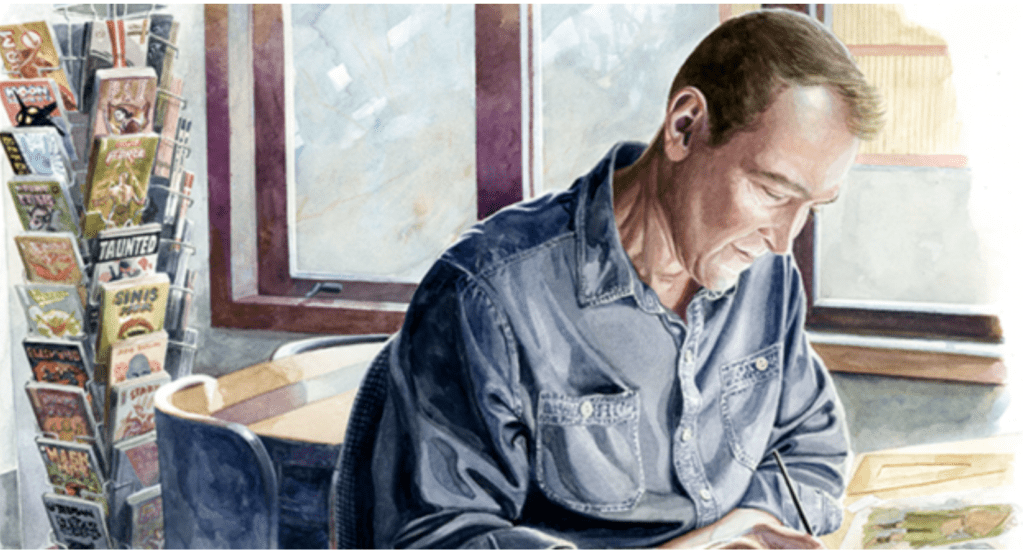J.G. Jones is a renowned comic book artist, illustrating covers of beloved superhero novels like Batman and Robin, Doc Savage, and Frankenstein. He has probably worked for all of the top businesses in the industry. His two and a half decades illustrating comics and cover art has taken a new shape this year when he illustrated a different type of superhero.
In the recent project Rare Reflections: MPNs Unmasked, Jones shines a spotlight on people living with a disease he knows well- myeloproliferative neoplasms (MPNs), a group of blood cancers. 10 years ago, Jones was diagnosed with the rare blood cancer polycythemia vera, which eventually became myelofibrosis, both of which are types of MPNs. This didn’t prevent him from continuing to pursue a rich career in comics and the arts. Now, he’s taking time to illustrate the many faces of the community with which he shares a disease. Jones said,
“Most of these people I’ve interviewed have been very passionate, very driven, and very determined. That’s the main thing that I like to illustrate. I like to show them living their passions, not their disease.”
Jones’ Art Route
Jones has been in the comic industry since he completed studying fine arts in university and moved to New York to become a painter. He quickly realized that was not the life for him. Jones said, “I took my portfolio to a comic con and got hired by the first person I showed it to. I have been working ever since, mostly in superhero comics.”
A self-portrait of J.G. made for the project
Jones’ Diagnosis
When J.G. was diagnosed with PV, he felt something common for rare disease patients- relief. Finding a doctor who can recognize the rare cancers often takes some time, and not knowing the diagnosis often means not knowing how to treat it. Getting a diagnosis gives answers- science, research, communities, doctors, statistics, treatment options. J.G. explained,
“It was actually a relief when I was first diagnosed to have answers to what were some pretty scary things that were happening. I was passing out at the drawing table and waking up hours later. I had strange itching, especially when I had hot showers. I was light headed, I had foggy thinking. It was really stressful not knowing what was going on, but when I got the diagnosis and could start treatment, I knew that it was going to be okay.”
Polycythemia Vera
Polycythemia vera (PV) is a rare blood cancer that causes blood to thicken over time due to the slow build up of red blood cells, white blood cells, and platelets. In Jones words,
“The disease is epitomized by all of the blood numbers being high generally. Everyone’s different but in my case, my platelets were high, my red count was sky high, and my white count was also elevated.”
The characteristic thick blood of PV patients can cause blood clots, heart attacks, strokes, and abnormal bleeding. While the progressive and slow nature of the illness means many patients are asymptomatic for years, others experience headaches, weakness, dizziness, itching, painful joints (particularly the big toe), excessive sweating, and more.
With answers in his hands, J.G. got to work to treat his disease and carry on with his busy life.
“I immediately got in treatment, got a really great specialist, and they got me under control…it stayed that way for the better part of 10 years, when oddly enough, the numbers flipped from being too high to too low. The bone marrow biopsy showed that I had transitioned from polycythemia vera to myelofibrosis.”
Summer is a preforming comedian who said using humor was the most important tool in helping her express herself and make it through the health journey.
Myelofibrosis
Myelofibrosis is a rare chronic type of bone marrow cancer, which causes bone marrow to not produce enough blood cells. This can cause anemia, fatigue, shortness of breath, weakness, fevers, night sweating, uncommon bruising, bone and joint pain, and more. Many treatment options exist which can alleviate symptoms, while other patients may be asymptomatic and not require treatment.
Carrying On Post-Diagnosis
Still, his diagnosis was just in the background of the long list of life events through J.G.’s decade. He said:
“I’ve always been the kind of person that just keeps driving forward so basically it was finding ways to live with the disease and not let it slow me down any more than was necessary.”
While he didn’t pump the breaks because of his disease, he did readjust his priorities. Instead of taking on the tight deadlines and rapid work to illustrate the comic story, he took on more projects for cover art which has more flexible hours. With less demanding deadlines, Jones was able to put his creative cap on for some other projects.
“I definitely decided that I can’t put things off that I had been putting off. For example, I had written a graphic novel with a friend of mine that I had been playing with on and off for about 10 years, and I just decided that, you know, no more messing around, and started active work on it recently.”
Illustrating Rare Reflections: MPNs Unmasked
When Jones sat down to work on Rare Reflections: MPNs Unmasked, he set out to understand the core of the people with whom he shared a disease. He would begin his work with a conversation, digging for their passion. The diagnostic story comes out in the writing, but he tries to capture them in their element in his illustration. Jones said,
“I try to find something that they’re really passionate about and illustrate them in that. One patient is a dancer, one patient is a comedian…[in order] to show that the disease does not define the patient. I’m a good example of that.”
Jones described the different patients he met with, which included a close friend he had met at a comic con, and another who’s passion for bicycling wound up leading to his diagnosis.
David is an avid cyclist, a passion which led to his diagnosis.
“Working in comics all these years gave me a suite of tools, and that’s basically story-telling. That’s why it’s so great to talk to people. You really get a feel for what they’re passionate about because they’ll talk about it quite a lot, often more than the disease. They like to tell you who they are, if you just let people talk they will tell you. So I kind of ask a few questions and just let them go.”
While he drew on the people’s individuality, when it came to the patient experience, he found those he interviewed were together in their resilience.
“Everyone has their own approach in life, but I have found everyone is very tenacious. They find a way to cope with the initial shock of the diagnosis and then almost immediately, find a way to live with it.”
——
As Jones approaches 25 years as a comic book artist, he doesn’t have any plans of quitting anytime soon. He’s still working on cover art, but he also dove into his own passions more.
“I think my shift in thinking was there are projects that I want to do for me, not necessarily for a paycheck – and those are things that I’m working on now. I’m doing a lot of things for me now. I’ve been working on illustrating one of my favorite books. I set up a painting studio in my house, and I started oil painting again. Seize the day, right?”
When asked to leave other rare disease patients with advice, Jones had something he learned from experience:
“Be your own self advocate. I can’t stress that enough. I’ve heard stories for people who fell in immediately with fantastic doctors, but also those whose initial encounter was with a doctor who didn’t understand or know that much about these diseases. Because they are rare and were unclear on their treatment, it wasn’t until they found a specialist that they began to get good treatment for their disease. So learn about it, talk to your doctor about it, if your doctor doesn’t seem clear about it, then find someone who is.”
To learn more about Rare Reflections: MPNs Unmasked and view the illustrations, visit www.VoicesofMPN.com/RareReflections.









